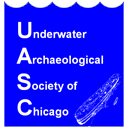By Medill students Phil Bencomo, Mark Bernstein, and Nick Cizek Jul. 08, 2011
Can you name something famous sitting at the bottom of Lake Michigan? The lakebed is actually littered with artifacts, like a WWI German U-Boat, dozens of WWII planes and more than a few noteworthy shipwrecks.
“We happen to live in an unusual part of the world,” says Brendon Baillod, an author and 20-year shipwreck hunter. He spoke at a recent meeting of the Underwater Archaeological Society of Chicago. “There were never as many vessels per square mile of water as there were during the industrial revolution on the Great Lakes. When you have a really high vessel density in a closed space, it causes lots of shipwrecks. There are about 8000 ships that have remains on the Great Lakes, we think.“
The Great Lakes are unique because the cold, fresh water preserves the ships. The Titanic sank in the Atlantic 99 years ago, and it’s already almost gone, eaten away by organisms and eroded by salt. But in the Great Lakes, some wrecks are nearly a century older. Divers tell stories of masts still attached and dining sets stacked in the cabinets, ready for another meal. And so, shipwreck hunters take to the lake with sidescan sonar rigs, searching the bottom for boat-like shapes. One of the most famous ships was found at the bottom of Lake Michigan in 1989.
The Lady Elgin sank in 1860 and now rests just off the coast of Highwood, about 30 miles north of Chicago. Valerie van Heest,
head of the Michigan Shipwreck Research Associates and author of “Lost on the Lady Elgin,” helped map the wreck.
“This was a case where 400 people boarded the passenger steamer Lady Elgin in Milwaukee for an excursion to Chicago to campaign for their hero Stephen Douglas, who was running for the presidential election against Abraham Lincoln,” she says. “It was a horrendous accident when the lumber schooner Augusta tore into the side of the Lady Elgin, tearing the ship in two and sending 400 people into the raging Lake Michigan.”
Only 100 people survived the wreck, leaving debris that stretched for miles behind them.
“And most significantly,” van Heest says, “we found 14 muskets that would have been destined for the Civil War had not the Lady Elgin sunk.”
Many wreck hunters are history buffs, but how did they get started?
“Well, I go back to the '50s when I was watching ‘Sea Hunt’,” says Kimm Stabelfeldt, director of the Great Lakes Shipwreck Research Foundation and 37-year shipwrecker. “Sea Hunt,” he explains, was a TV show about the adventures of an ex-navy frogman. “You saw him standing on the deck there, throw his tanks on, and put on his double-hose regulator, and you went, Wow, that's really cool. Seeing something underwater. A lot of the older divers, like myself, when you talk to them, they'll bring up ‘Sea Hunt.’”
And so off they go onto the open water, the “Sea Hunt” theme happily stuck in their heads.
“Searching is very boring,” says Taras Lyssenko, a longtime wreck hunter and the T in A&T Recovery, a firm that pulls those lost
WWII training planes from Lake Michigan for the Navy. “Lots of tedious long hours of back and forth, watching the sonar system till you find it.
“The boat leaves the dock at 7:00 a.m with all the equipment, the crew and everything,” he adds, “and we search for 12 hours. And the next morning we come back and do it again, as long as the weather’s OK.”
David Trotter has discovered nearly 100 wrecks over five decades. “The discovery can occur quickly,” he says, “or it can take years.”
That’s no exaggeration. Trotter himself once spent 15 years looking for a single ship.
The mechanics of searching for a wreck are actually quite simple. You pick a search grid and tow a sonar system behind your boat, strip by strip, until you find something. It’s as time-consuming as it sounds.
“We call it mowing the lawn,” Trotter says. And it’s expensive, too. Those high-end sonar systems can run up to $50,000, used. So why do these weekend explorers do it? For a couple of artifacts? Actually, it’s illegal to take anything at all from a wreck. But every time we dug deep enough, we found another shipwreck hunter, like Stabelfeldt, just trying to be a kid again.
“I wanted to be a cowboy when I was a kid,” Stabelfeldt says. “Couldn’t do that, there weren’t any cowboys left, so now I’m a cowboy on the lake.”
“There’s a great cartoon, Calvin and Hobbes, and I always loved this,” Lyssenko says of his inspiration. “He’s digging in the backyard and the Tiger comes and says, ‘What are you doing?’ And he says, ‘I’m hunting for buried treasure.’ And he says, ‘How are you doing?’ He says, ‘I’ve got a couple of these rocks, some grubs, a disgusting worm.’ He says, ‘There’s treasure everywhere.’ The thing about the boy who understands that is, he understands what treasure is. Treasure’s not what all those people in the city of Chicago think it is, it’s what you believe it is.”
And every now and then, these shipwreck hunters find a treasure that everyone can agree on. That wreck from March, an incredibly well-preserved virgin sloop built nearly 200 years ago, made headlines as far away as Japan. It’s just the type of story that could inspire the next generation of explorers.
